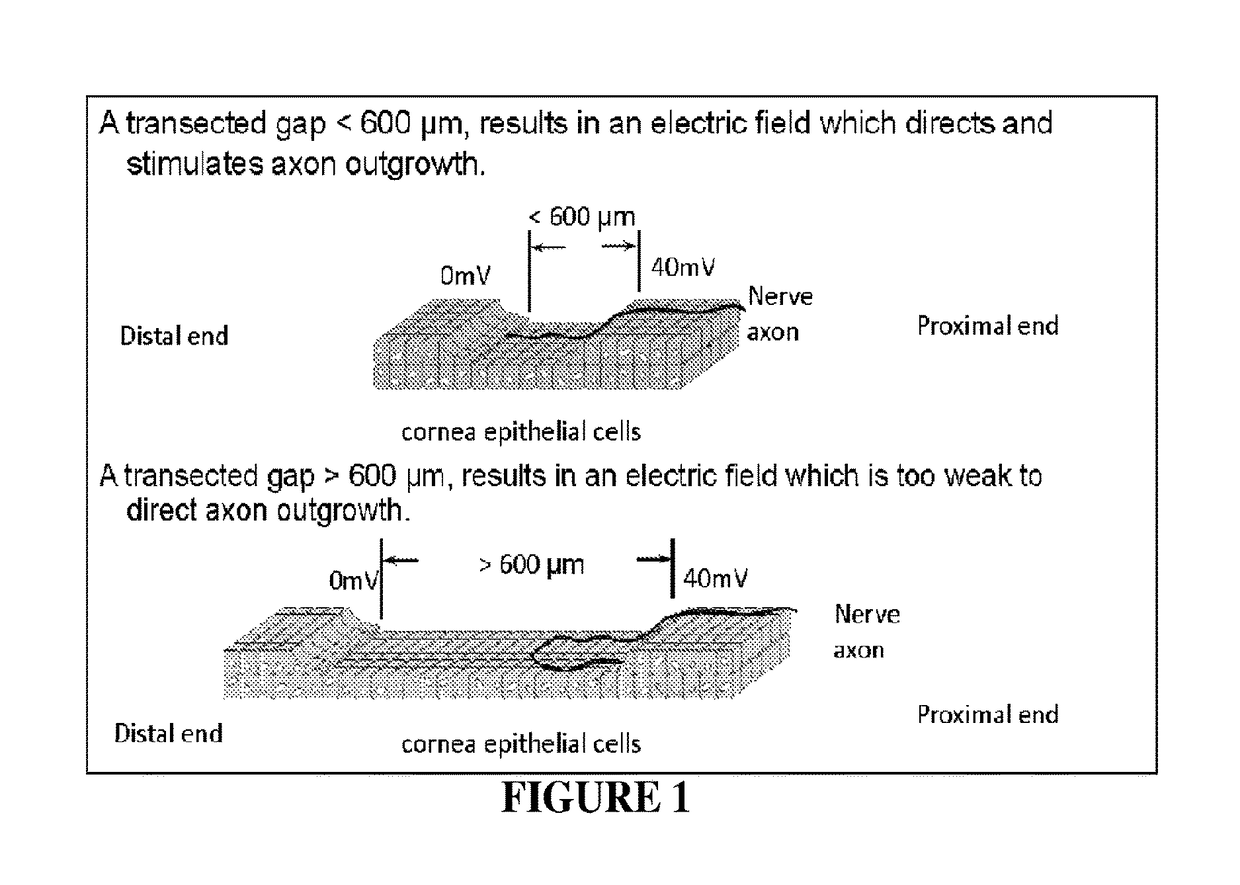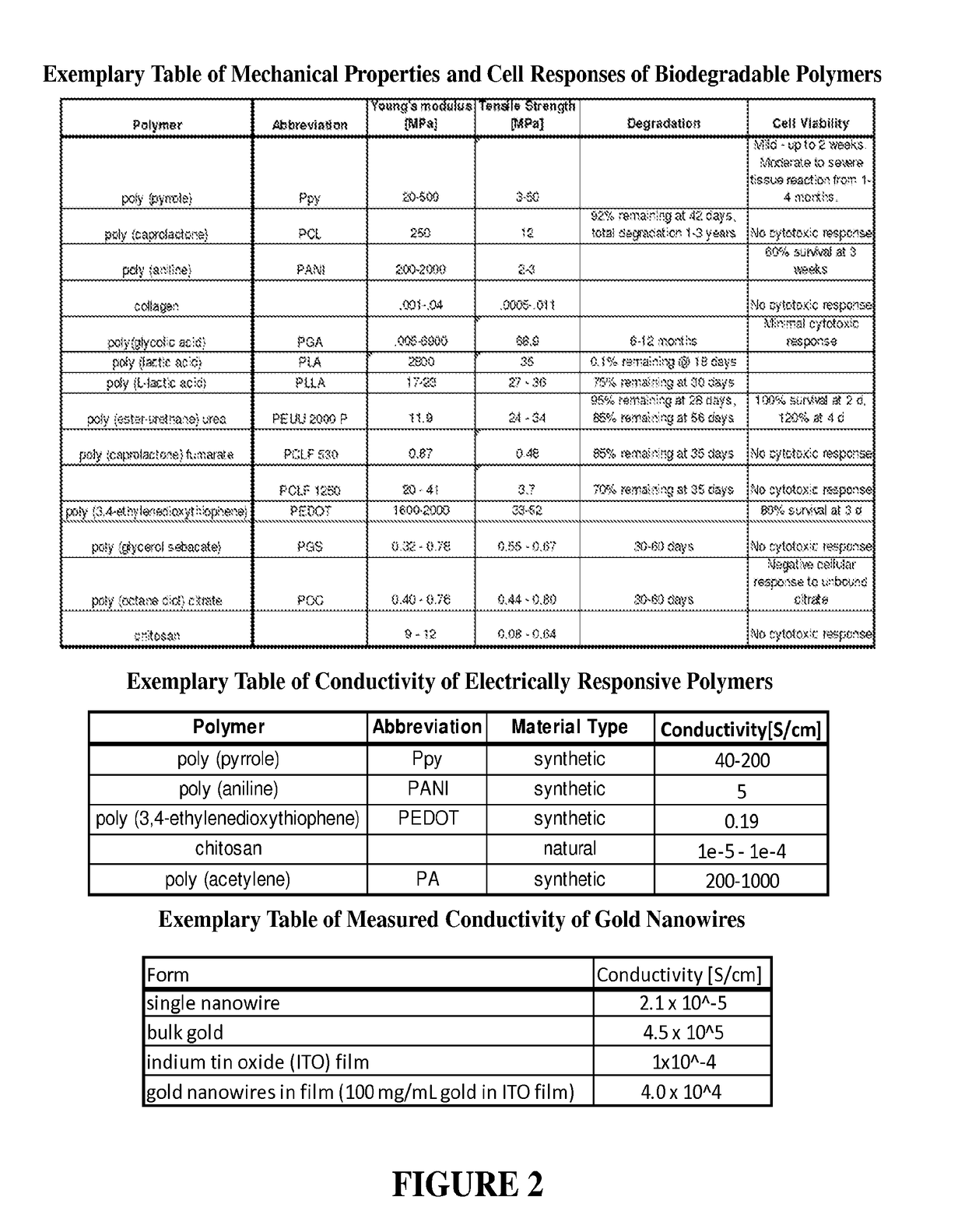Conduit for peripheral nerve replacement
a peripheral nerve and conduit technology, applied in the field of biphasic materials and devices, can solve the problems of limiting the repair of peripheral nerves to a maximum gap of 3 cm, no treatment options are available for over 87, and ineffective attempts to surpass the 3 cm boundary
- Summary
- Abstract
- Description
- Claims
- Application Information
AI Technical Summary
Benefits of technology
Problems solved by technology
Method used
Image
Examples
example 1
[0095]Conductive materials can be enhanced by low concentrations (0-5%) of metal nanowires to increase material conductivity. We have synthesized silver nanowires with resulting solutions comprised of short nanorods (aspect ratio (A.R.): 6.1±0.64 nm), medium length nanorods (A.R: 17.0±0.06), and long nanowires (AR: 34.02±3.01). We incorporated low concentrations (0-5% by weight) of the prepared silver nanorods into chitosan films (conductivity=10−6 S / cm) to evaluate changes in conductivity. We have achieved silver nanorods in the desired size range and successfully generated chitosan films doped with silver nanowires. (See FIGS. 6 and 7). Stable chitosan conductivity measures require input voltages in the range of 2 to 100 kV to achieve read voltages in the range of 2-100 V across the film. Distinction of conductivity for nanowire doping variation requires minimum input voltages of 10 kV. These input voltages are not reasonable options for human or animal modeling. These experiments...
example 2
[0096]A conduit of the present invention was prepared and tested utilizing PGSA. See FIG. 8.
[0097]Methods.
[0098]PGS was prepared by melting sebacic acid (Sigma 283258) in an oil bath at 180° C., under nitrogen. Glycerol (Fisher Scientific G33) preheated to 100° C. was added dropwise to sebacic acid (3:1 w / v sebacic acid: glycerol). The prepolymer was completed by applying 15 in Hg vacuum pressure while stirring 4 hours with the oil bath maintained at 150° C.
[0099]Synthesis of PGSA.
[0100]PGSA was prepared by melting PGS into an excess solution of dichloromethane (Fisher D37). PGS was acrylated to 25, 30, 35, and 40% of its hydroxyl groups using 25, 30, 35, or 45% molar amounts of acryloyl chloride (Sigma A24109). Hydrochloric acid was removed from equilibrium via vaporization with the dropwise addition of triethylamine (Sigma T0886) (1.2:1.0, triethylamine:acryolyl chloride). Dichloromethane was removed by rotovaporization. Triethylamine salts were precipitated from the solution usin...
example 3
[0158]Prospective Development and Evaluation of an Additional Segmented Conduction Conduit
[0159]Results from one hour of AC electrical stimulation of nerves proximal to the site of injury demonstrate axon regeneration rate increase over three times compared to the untreated rate of regeneration. The observation in the axon extension process following electrical stimulation is a decreased delay time for axon elongation and increased axon sprouts. These repair actions over a limited time range motivate evaluation of extended stimulation. However, extended stimulation time yielded no improvement. Reflection on newt limb and bovine corneal studies implies that the limiting factor may be distance of effectiveness of single point electrical stimulation (measured as 600 μm), rather than time length of stimulation. This observation provides further biological support for incremental electrical field stimulation. To answer the question: “Is the critical gap size for nerve repair limited by t...
PUM
| Property | Measurement | Unit |
|---|---|---|
| conductivity | aaaaa | aaaaa |
| conductivity | aaaaa | aaaaa |
| length | aaaaa | aaaaa |
Abstract
Description
Claims
Application Information
 Login to View More
Login to View More - R&D
- Intellectual Property
- Life Sciences
- Materials
- Tech Scout
- Unparalleled Data Quality
- Higher Quality Content
- 60% Fewer Hallucinations
Browse by: Latest US Patents, China's latest patents, Technical Efficacy Thesaurus, Application Domain, Technology Topic, Popular Technical Reports.
© 2025 PatSnap. All rights reserved.Legal|Privacy policy|Modern Slavery Act Transparency Statement|Sitemap|About US| Contact US: help@patsnap.com



